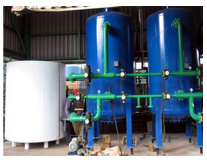Softeners
Water softeners ion exchange are generally used as equipment to prepare the water low pressure boilers, heating systems or where water supply has calcium and magnesium specially, which must be removed.
Aguasin has a standard line of these teams (in manual and automatic), as well as equipment made of steel or reinforced fiber.
In addition to traditional softeners (co-current, manual or automatic), there are designs to optimize the softening process. In this case, the design of softeners is counter-current fixed bed, packed, etc., Which also operates manually or automatically. For this design, the teams are calculated depending on the application and water quality to be achieved.
In Aguasin we count with professionals dedicated to delivering the best solutions. Contact Us and we will answer your request.

Co-current/Counter-current
Water softeners that have a resin bed must be regenerated with brine to restore the ability to retain salts that make water hard. The regeneration may be in the same direction of flow of water (co-current) or can be in reverse flow (counter-current). Both options require a special design from the team softener, and have advantages and disadvantages that should be analyzed to decide which model to use in each application.
Manuals and Automatic
The water softeners have five cycles of operation: service, backwash, brine suction, slow-moving and quick wash. These five cycles are performed in a sequence and through a set of valves, arranged in a manifold for performing these functions. The valves can be manually operated and controlled by an operator, which in turn must control the time each cycle has, or automatic valve can be electric or pneumatic, which on the instructions of a controller or electro-mechanical a logic program performs the opening and closing, in a predetermined sequence.
• Technical HAA, HAA-C
• Technical HMA, HA
